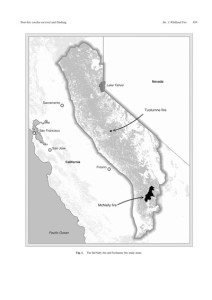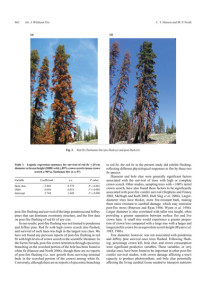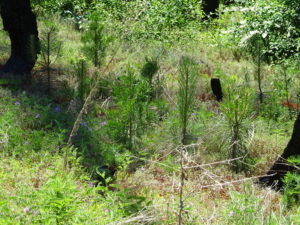Stanislaus National Forest
[cmsms_row data_padding_bottom=”60″ data_padding_top=”0″ data_bg_color=”#7b8855″ data_bg_color_custom=”true” data_color=”first” data_padding_right=”15″ data_padding_left=”15″ data_width=”fullwidth”][cmsms_column data_width=”1/1″][cmsms_image align=”center” animation=”fadeIn” animation_delay=”0″]2310|http://johnmuirproject.org/wp-content/uploads/2015/04/sierramap.gif|full[/cmsms_image][cmsms_text animation_delay=”0″]
Scroll down to watch a Video Presentation on the Ecological Benefits of California’s Rim Fire, to view Scientific Research on Flushing, and to learn about Spotted Owl Occupancy in the Rim Fire Area.
[/cmsms_text][/cmsms_column][/cmsms_row][cmsms_row data_padding_bottom=”60″ data_padding_top=”80″ data_overlay_opacity=”80″ data_color_overlay=”#000000″ data_overlay_show=”true” data_bg_parallax=”true” data_bg_size=”cover” data_bg_attachment=”scroll” data_bg_repeat=”no-repeat” data_bg_position=”top center” data_bg_img=”1305|http://johnmuirproject.org/wp-content/uploads/2015/01/fisher_back-300×225.png|medium” data_color=”first” data_width=”boxed”][cmsms_column data_width=”1/1″][cmsms_text animation=”fadeIn” animation_delay=”0″]
In the summer of 2013, the Rim fire spanned 257,314 acres, mostly on the Stanislaus National Forest, and partly in Yosemite National Park and some private timberlands.
About 59% of the fire area occurred in conifer forest types (the rest was in oak woodland, chaparral, and grassland), and 20% of the conifer forest experienced high-intensity fire effects (wherein most or all trees were killed), while 80% experienced low/moderate-intensity fire. In the high-intensity fire areas within conifer forest, the fire created “complex early seral forest” (CESF) habitat—the rarest, most biodiverse, most wildlife-rich, and most threatened forest habitat type in the Sierra Nevada.
[/cmsms_text]
[cmsms_text]
[/cmsms_text][cmsms_text]
[/cmsms_text][cmsms_text]
[/cmsms_text][cmsms_text]
[/cmsms_text][cmsms_text]
[/cmsms_text][cmsms_text]
[/cmsms_text][cmsms_image align=”center” link=”http://johnmuirproject.org/wp-content/uploads/2015/04/CESFLupineRim.jpg” animation=”fadeIn” animation_delay=”0″]1912|http://johnmuirproject.org/wp-content/uploads/2015/04/CESFLupineRim-580×460.jpg|project-thumb[/cmsms_image][/cmsms_column][/cmsms_row][cmsms_row data_padding_bottom=”20″ data_padding_top=”0″ data_bg_color=”#ffffff” data_bg_color_custom=”true” data_color=”default” data_padding_right=”15″ data_padding_left=”15″ data_width=”fullwidth”][cmsms_column data_width=”1/1″][cmsms_heading type=”h2″ font_weight=”400″ font_style=”normal” text_align=”center” target=”self” margin_top=”50″ margin_bottom=”20″ animation_delay=”0″]Rim Fire of 2013[/cmsms_heading][cmsms_heading type=”h3″ font_weight=”400″ font_style=”normal” text_align=”center” target=”self” margin_top=”0″ margin_bottom=”20″ animation_delay=”0″]Watch the video presentation below to learn more about the Rim Fire and its ecological benefits.[/cmsms_heading][cmsms_embed link=”https://vimeo.com/95535429″ wrap=”true” animation_delay=”0″][cmsms_text animation_delay=”0″]
In this Vimeo video of Chad Hanson’s presentation, Dr. Hanson mentions that the Forest Service’s claim that 40% of the fire area burned at high intensity was an overestimation. Four months after he gave this presentation, when the final burn severity mapping was completed by the U.S. government’s MTBS (Monitoring Trends in Burn Severity) Program, that figure was reduced to 19.9% high intensity fire—NOT the 40% originally claimed.
[/cmsms_text][cmsms_heading type=”h3″ font_weight=”400″ font_style=”normal” text_align=”center” target=”self” margin_top=”30″ margin_bottom=”20″ animation_delay=”0″]Compare for Yourself[/cmsms_heading][cmsms_text animation_delay=”0″]
The RAVG (Rapid Assessment of Vegetation Condition after Wildfire) map created by U.S. Forest Service staff one month after the Rim Fire burned with the MTBS map created one year after the Rim Fire burned.
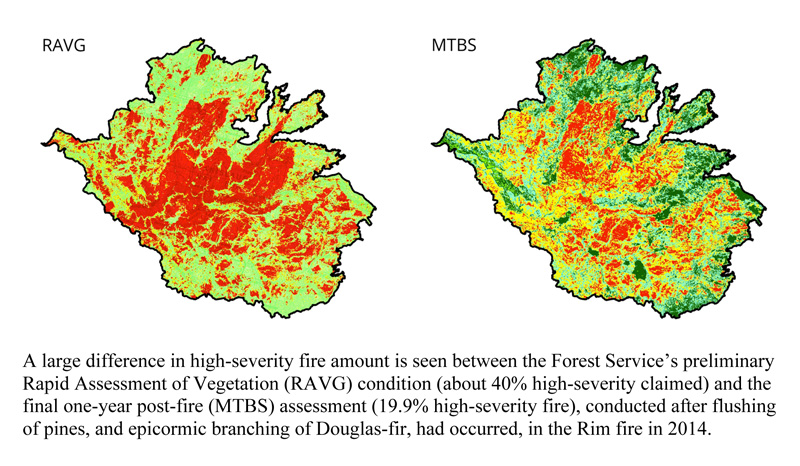
The reason the initial mapping is so inaccurate is due to the natural phenomenon of “flushing”. Flushing occurs in ponderosa pines when their needles are killed by the radiant heat of the fire (i.e., all of their needles turn brown) and, although they look dead, the trees are not killed by the fire. In the first growing season after the fire the trees sprout new green foliage from the buds at the end of their branches (terminal buds) which are protected from the radiant heat – Take a look!
[/cmsms_text][cmsms_heading type=”h3″ font_weight=”400″ font_style=”normal” text_align=”center” target=”self” margin_top=”30″ margin_bottom=”20″ animation_delay=”0″]Flushing of Ponderosa Pine trees within the Rim Fire area May 2014.[/cmsms_heading][/cmsms_column][/cmsms_row][cmsms_row data_padding_bottom=”80″ data_padding_top=”0″ data_bg_color=”#ffffff” data_bg_color_custom=”true” data_color=”default” data_padding_right=”15″ data_padding_left=”15″ data_width=”fullwidth”][cmsms_column data_width=”1/3″][cmsms_image align=”center” link=”http://johnmuirproject.org/wp-content/uploads/2015/04/PinesFlushing31.jpg” animation_delay=”0″]2113|http://johnmuirproject.org/wp-content/uploads/2015/04/PinesFlushing31.jpg|full[/cmsms_image][/cmsms_column][cmsms_column data_width=”1/3″][cmsms_image align=”center” link=”http://johnmuirproject.org/wp-content/uploads/2015/04/PinesFlushing2.jpg” animation_delay=”0″]1923|http://johnmuirproject.org/wp-content/uploads/2015/04/PinesFlushing2.jpg|full[/cmsms_image][/cmsms_column][cmsms_column data_width=”1/3″][cmsms_image align=”none” link=”http://johnmuirproject.org/wp-content/uploads/2015/04/PinesFlushing3.jpg” animation_delay=”0″]1922|http://johnmuirproject.org/wp-content/uploads/2015/04/PinesFlushing3.jpg|full[/cmsms_image][/cmsms_column][/cmsms_row][cmsms_row data_width=”fullwidth” data_padding_left=”15″ data_padding_right=”15″ data_color=”second” data_bg_color_custom=”true” data_bg_color=”#364e62″ data_padding_top=”60″ data_padding_bottom=”30″][cmsms_column data_width=”1/1″][cmsms_heading type=”h2″ font_weight=”400″ font_style=”normal” text_align=”center” target=”self” margin_top=”0″ margin_bottom=”40″ animation_delay=”0″]Upwards of 80% of the trees that flush survive long-term.[/cmsms_heading][cmsms_text animation_delay=”0″]
[/cmsms_text][/cmsms_column][/cmsms_row][cmsms_row data_width=”fullwidth” data_padding_left=”15″ data_padding_right=”15″ data_color=”default” data_bg_color_custom=”true” data_bg_color=”#ffffff” data_padding_top=”0″ data_padding_bottom=”10″][cmsms_column data_width=”1/1″][cmsms_heading type=”h2″ font_weight=”400″ font_style=”normal” text_align=”center” target=”self” margin_top=”50″ margin_bottom=”20″ animation_delay=”0″]Rim Fire Logging Project[/cmsms_heading][cmsms_heading type=”h3″ font_weight=”400″ font_style=”normal” text_align=”center” target=”self” margin_top=”0″ margin_bottom=”20″ animation_delay=”0″]The Complex Early Seral Forest (CESF) created by the Rim fire is primarily on the Stanislaus National Forest.[/cmsms_heading][cmsms_text animation_delay=”0″]
Even though 150 scientists from across the country submitted comments urging the Forest Service not to log this important habitat, the U.S. Forest Service issued a decision in late summer of 2014 to essentially clearcut most of this rare and imperiled habitat within the Rim fire area on the Stanislaus National Forest. Approximately 19,000 acres of CESF was created and the Forest Service plans to log approximately 13,000 acres (68%) even though less than 3% of the Stanislaus National Forest is comprised of CESF (due to forest management practices such as fire suppression, post-fire logging, removal of native shrubs and artificial tree plantation establishment).
In addition to removing habitat essential to the imperiled Black-Backed Woodpecker and other complex early seral bird species which are now thriving in the high intensity burn patches in the Rim Fire area, the Forest Service has approved logging in every single California spotted owl territory which was occupied after the fire. To make matters worse, they never told the public that spotted owls were actively using the fire area, or that spotted owl occupancy increased after the Rim fire, and they never analyzed the impacts of extensively logging owl territories (including nest stands) on the owls themselves.
[/cmsms_text][/cmsms_column][/cmsms_row][cmsms_row data_width=”fullwidth” data_padding_left=”20″ data_padding_right=”20″ data_color=”default” data_bg_color_custom=”true” data_bg_color=”#ffffff” data_padding_top=”0″ data_padding_bottom=”30″][cmsms_column data_width=”1/2″][cmsms_image align=”none” link=”http://johnmuirproject.org/wp-content/uploads/2015/04/MapShowingLoggingAndCSO.pdf” animation_delay=”0″]1939|http://johnmuirproject.org/wp-content/uploads/2015/04/MapShowingLoggingAndCSO.jpg|full[/cmsms_image][cmsms_text animation_delay=”0″]
Occupied California Spotted Owl territories
overlaid on Rim Fire Logging Project.
[/cmsms_text][/cmsms_column][cmsms_column data_width=”1/2″][cmsms_image align=”none” link=”http://johnmuirproject.org/wp-content/uploads/2015/04/ExampleOfLoggingIn1RimOwlTerritory.pdf” animation_delay=”0″]1940|http://johnmuirproject.org/wp-content/uploads/2015/04/ExampleOfLoggingIn1RimOwlTerritory.jpg|full[/cmsms_image][cmsms_text animation_delay=”0″]
Intensity of logging within one occupied
California Spotted Owl Territory.
[/cmsms_text][/cmsms_column][/cmsms_row][cmsms_row data_width=”fullwidth” data_padding_left=”15″ data_padding_right=”15″ data_color=”default” data_bg_color_custom=”true” data_bg_color=”#ffffff” data_padding_top=”0″ data_padding_bottom=”50″][cmsms_column data_width=”1/1″][cmsms_heading type=”h3″ font_weight=”400″ font_style=”normal” text_align=”center” target=”self” margin_top=”0″ margin_bottom=”20″ animation_delay=”0″] Because of these failures, JMP joined the Center for Biological Diversity in filing suit to stop the logging within the 39 occupied owl territories.[/cmsms_heading][cmsms_button button_link=”http://johnmuirproject.org/legal-pursuits/rim-post-fire-logging-litigation/” button_target=”self” button_text_align=”center” button_font_size=”15″ button_font_weight=”normal” button_font_style=”normal” button_padding_hor=”20″ button_bg_color=”#212221″ button_text_color=”#ffffff” button_bg_color_h=”#212221″ animation_delay=”0″]Learn More About the Lawsuit[/cmsms_button][/cmsms_column][/cmsms_row][cmsms_row data_padding_bottom=”50″ data_padding_top=”60″ data_bg_color=”#7b8855″ data_bg_color_custom=”true” data_color=”first” data_padding_right=”15″ data_padding_left=”15″ data_width=”fullwidth”][cmsms_column data_width=”1/1″][cmsms_heading type=”h2″ font_weight=”400″ font_style=”normal” text_align=”center” target=”self” margin_top=”0″ margin_bottom=”40″ animation_delay=”0″]Keeping the money for themselves[/cmsms_heading][cmsms_text animation_delay=”0″]
In addition to enriching the timber industry by selling off this habitat on our public lands for less than 2 cents per board foot of timber, under current laws, when the Forest Service sells trees from a burn area they get to keep 100% of the revenue to enhance its budget and to pay its staff to carry out future post-fire logging projects. This creates a strong financial conflict of interest for the agency to pursue such destructive commercial logging projects, which often leads to decisions which are not scientifically accurate, which destroy rare and important wildlife habitat, and which do not comply with federal environmental laws.
For instance, the Forest Service insists that they must log supposedly to raise money to plant trees so a forest will grow back. Not so. There is abundant natural post-fire conifer regeneration in the Rim Fire (and every other) burn area.
May 2014: Naturally regenerating conifer seedlings in unlogged high intensity fire patches in the Rim Fire.

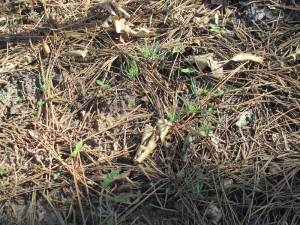
December 2014: Naturally regenerating conifer seedlings in unlogged high intensity fire patches in the Rim Fire.
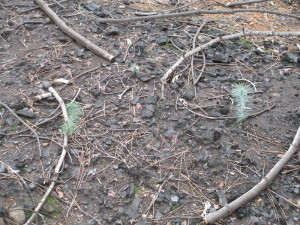
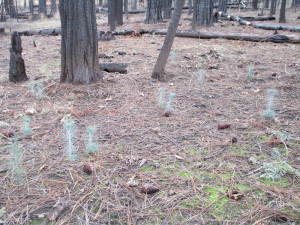
May 2015: Video of naturally regenerating conifer seedlings in unlogged high intensity fire patches in the Rim Fire.
[cmsms_embed link=”https://youtu.be/qUrL0h6VAz0″ wrap=”true” animation_delay=”0″]
May 2016: Naturally regenerating conifer seedlings in unlogged high intensity fire patches in the Rim Fire.
Not only is it unnecessary to log these areas for a forest to regrow, logging actually destroys the tree seedlings that are already growing, necessitating the replanting of these areas by hand. Based on the cost of these artificial planting operations, JMP estimates that the logging will actually cost taxpayers at least $15 million dollars!
The effects of logging activities and equipment, Rim Fire Area December 2014.
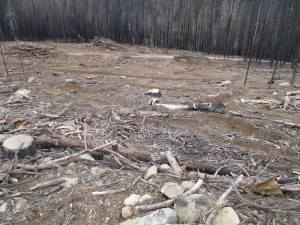
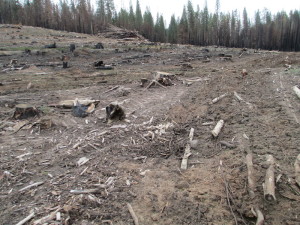
The Forest Service also claims they must log to reduce fuel loads to prevent another fire. Again, not so. Scientific research done on this subject has found that: (a) post-fire logging increases fire intensity; and (b) post-fire logging does not actually reduce fuel loads when compared to areas that were left to natural succession (i.e., not managed or logged) after the fire.
Email us if you would like these studies: Dunn and Bailey (2015); Donato et al. (2013); McGinnis et al. (2010); Thompson et al. (2007); Donato et al. (2006).
[/cmsms_text][/cmsms_column][/cmsms_row][cmsms_row data_width=”fullwidth” data_padding_left=”15″ data_padding_right=”15″ data_color=”default” data_bg_color_custom=”true” data_bg_color=”#ffffff” data_padding_top=”50″ data_padding_bottom=”30″][cmsms_column data_width=”1/1″][cmsms_heading type=”h2″ font_weight=”400″ font_style=”normal” text_align=”center” target=”self” margin_top=”0″ margin_bottom=”20″ animation_delay=”0″]Related Documents[/cmsms_heading][cmsms_text animation_delay=”0″]
Scoping Comments from 150 Scientists
Draft EIS Comments from Wild Nature Institute
Draft EIS Comments California Chaparral Institute
Supplemental Letter Regarding California Spotted Owl Occupancy
[/cmsms_text][/cmsms_column][/cmsms_row][cmsms_row data_width=”fullwidth” data_padding_left=”15″ data_padding_right=”15″ data_color=”second” data_bg_color_custom=”true” data_bg_color=”#364e62″ data_padding_top=”60″ data_padding_bottom=”30″][cmsms_column data_width=”1/1″][cmsms_heading type=”h2″ font_weight=”400″ font_style=”normal” text_align=”center” target=”self” margin_top=”0″ margin_bottom=”40″ animation_delay=”0″]Rim Fire “Reforestation” Project[/cmsms_heading][cmsms_text animation_delay=”0″]
After the Forest Service destroys this habitat through logging and kills the already abundant naturally regenerating trees, next on the list is their proposal for an enormous taxpayer-subsidized program to eliminate native shrubs (by spraying toxic herbicides that endanger threatened amphibians, such as the Yosemite Toad and Mountain Yellow-legged Frog) and establish artificial tree plantations across tens of thousands of acres.
JMP and CBD Rim Fire Reforestation Scoping Comments
JMP and CBD Rim Fire Reforestation Draft Environmental Impact Statement (DEIS) Comments
California Chaparral Institute’s Comments on the Rim Reforestation DEIS
Public review of this proposed project just started, so check back for more information throughout 2015-2016.
[/cmsms_text][/cmsms_column][/cmsms_row]


